The Best New Vegetables, Herbs, and Fruits of 2023
January 10th, 2023
Seedless peppers, a basil that fights off a troublesome disease, and a tomato bred for dipping highlight the list of what’s new in home-garden edibles for 2023.
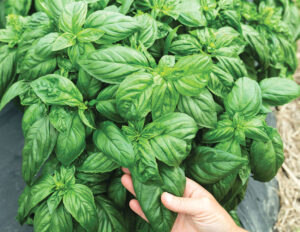
Basil ‘Prospera.’ (Credit: Johnny’s Selected Seeds)
Those are just a few of the many interesting new plants debuting this year.
I’ll zero in on some of the year’s best new introductions this month, starting today with the Best New Vegetables, Herbs, and Fruits of 2023 and continuing with the Best New Annual Flowers of 2023, the Best New Perennial Flowers of 2023, and the Best New Trees and Shrubs of 2023 the following three weeks.
Some of the following new edibles are already available in seeds or plants online and in catalogs. If any strike your fancy, it’s best to order ASAP before the supply dwindles.
Local garden centers may carry at least some of these – seeds already and plants in April and May.
Here’s what’s new and worth checking out:
Basil Prospera
Basil used to be a fairly bullet-proof herb in home gardens until a downy-mildew disease emerged in Switzerland in 2003 and soon spread throughout the world. The disease now often causes deformed, spotted leaves in U.S. farms and gardens.
To combat the problem, researchers in Israel teamed up with Israel-based Genesis Seeds to develop a hybrid called Prospera that uses mildew-resistant genes from wild basil.
Seeds of Prospera basil are debuting this year in the Johnny’s Selected Seeds and Harris Seeds catalogs.
Johnny’s also is carrying Prospera Red, the first purple-leafed basil with high resistance to downy mildew.
Both of these disease-resistant, heat-tough basils grow 16 to 18 inches tall and do well in the ground as well as in pots. They grow best in full sun.
Prospera’s arrival gives a less-expensive seed option to Amazel, a variety introduced two years ago as a costlier plant-only, mildew-resistant choice.
Seedless sweet pepper Pepper Pots Sugar Kick
The breakthrough in this new sweet pepper in Proven Winners’ Proven Harvest line is that the fruits are seedless (at least when plants are kept isolated from other sweet peppers).

Pepper Pepper Pots Sugar Kick (Credit: Proven Harvest)
Pepper Pots Sugar Kick produces a heavy yield of four- to six-inch cone-shaped fruits that are exceptionally sweet and crisp.
Fruits are ready to eat green 54 days after setting plants out in the garden. Or wait another 20 days if you want mature orange fruits.
Sugar Kick grows 20 to 30 inches tall, compact enough for growing in pots as well as in the ground. Production is best in full sun.
Sweet pepper Peppers from Heaven
New in the Burpee Plants brand for 2023 is a compact, heavy-producing, three-color collection of sweet peppers called Peppers from Heaven.
“The plants stay small but produce plenty of fleshy fruits that turn from green to glossy colors,” says Katie Rotella, a spokesperson for Ball Horticultural Co., the grower that’s introducing the collection. “There are three colors to choose from – Red, Yellow, and Orange.”
Rotella says the plants grow just eight inches tall and a foot wide, making them ideal for small gardens, pots, window boxes, and hanging baskets.
“Plant three plants in one pot for a fuller look, or mix colors for a uniquely colorful sweet pepper basket,” she says.
Peppers from Heaven fruits are ready to harvest in 70 to 80 days. Best in full sun.
Pepper Trailblazer
This heavy-producing yellow sweet pepper is a good enough newcomer to earn Chris Wallen’s pick as the best new vegetable variety of 2023.
Wallen, the head annual grower at wholesale Quality Greenhouses near Dillsburg, says Trailblazer has excellent disease resistance, is quick to mature, is a good keeper after picking, and has a “lovely sweet flavor.”
“I trialed this pepper in my personal garden and in containers at work,” he says, “and it got no blossom end rot, even in containers. It has remarkably strong stems and is definitely a superior variety, probably the best yellow bell on the market today.”
Plants grow about two feet tall, ideally in full sun.
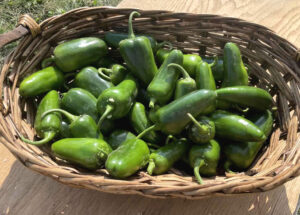
Jalapeno pepper San Joaquin. (Credit: All America Selections)
Jalapeno pepper San Joaquin
Two new vegetables were strong enough performers in nationwide trials last year to earn All-America Selections national awards for 2023.
The first 2023 national winner is a hybrid jalapeno pepper called San Joaquin that matures most of its fruit in a short time frame, making it ideal for those growing jalapenos for canning, pickling, or making salsa.
San Joaquin’s fruits are ready to pick green 60 days from planting and will mature to red if left in the garden. They’re mild in heat content (“just a hint of heat,” according to the AAS judges).
Expect about 50 four-inch fruits per 30-inch-tall plant.
AAS judges also mentioned the variety’s thick-walled fruits that make them resistant to cracking. Production is best in full sun.
Squash Sweet Jade
The second 2023 AAS national winner is this single-serving-sized hybrid winter squash from Johnny’s Selected Seeds that’s both high-yielding and long-keeping.
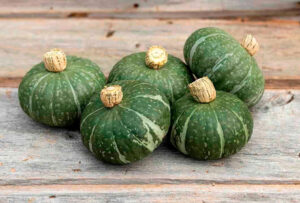
Squash Sweet Jade (Credit: All-America Selections)
The fruits of Sweet Jade, a kabocha-type squash, are only four to five inches around and weigh one to two pounds each.
The round, flat-topped green fruits are deep orange inside with a dry yet sweet flavor.
AAS judges said the size makes them ideal for single servings of roasted squash, as an edible soup bowl, or “in any Asian-style dish where a sweet, earthy, nutritious squash is typically used.”
Sweet Jade plants have a vining habit that can send arms out six to eight feet, so give them plenty of room or support in the garden.
Fruits are ready to harvest 85 days from transplant or 100 days from direct-seeding. Production is best in full sun.
Tomato Sun Dipper
An interesting new twist in tomatoes is a variety bred to make dipping easy.
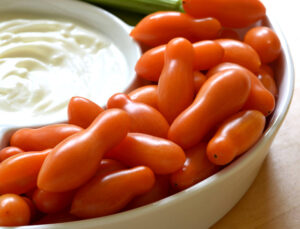
Fruits of Sun Dipper tomato (Credit: Ball Horticultural Co.)
Sun Dipper is a disease-resistant new introduction in PanAmerican Seed’s HandPicked Vegetables Collection that produces small orange fruits shaped like miniature bowling pins. The shape essentially creates handles that allow dipping the fatter, lower part of the fruit without getting the sauce or dressing on your fingers.
I test-grew a couple of Sun Dipper plants last summer and found the fruits to be good in the taste department and thick-skinned enough to resist the cracking that’s common in so many small-fruited tomatoes.
The variety also earned a 2023 National Garden Bureau Green Thumb award as the year’s best new edible plant.
Mature fruits are ready in 60 to 65 days, and plants are indeterminate, meaning they continue producing until frost ends the season.
Galaxy Suite tomatoes
Another tasty line of cherry-type tomatoes is the Galaxy Suite series, bred by Cornell University’s Dr. Philip Griffiths for High Mowing Organic Seeds.
Griffiths set out to tackle the fruit-cracking problem and succeeded in developing seven cherry and grape types that not only resist cracking and keep longer but that have exceptional flavor.
The newest introduction to the series is ‘Moonshadow,’ a grape-shaped tomato with purplish-red fruits.
Others include ‘Comet’ (a red grape-type), ‘Midnight Pear’ (a pear-shaped purplish fruiter), ‘Moonbeam’ (a pear-shaped yellow fruiter), ‘Starlight’ (an elongated golden grape-type), ‘Sungazer’ (an orange grape-type), and ‘Supernova’ (an orange-red grape-type).
All are indeterminate and produce ripe fruits in 60 to 70 days.
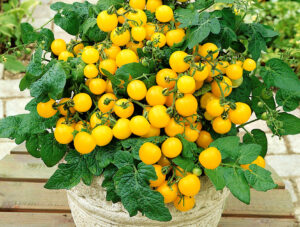
Tomato Patio Sunshine (Credit: Proven Harvest)
Container tomato Tempting Tomatoes Patio Sunshine
This super-compact tomato was bred for growing in pots, baskets, and window boxes and produces heavy yields of golden cherry-type tomatoes on plants that grow only about 18 inches tall and a foot across.
Patio Sunshine is one of three new-for-2023 tomatoes in the Proven Harvest’s Tempting Tomatoes line and is one of the most compact varieties on the market yet.
The variety is indeterminate and typically produces about 100 inch-round fruits per plant.
The flavor is described as “mildly sweet,” plants are disease-resistant, and fruits are quick to mature, turning color about 45 days after planting.
The other two new Tempting Tomatoes for 2023 are Bellini, a crack-resistant cherry type with sweet, orange, low-acid fruits, and Garden Treasure, a mid-season red slicer bred for heirloom flavor.
Tomato Vivacious
One other tomato hitting the seed market in 2023 is a variety from Bucks County’s W. Atlee Burpee Seed Co. that focuses on high nutrition.
Vivacious is a hybrid that produces three-inch, orange-scarlet fruits with extra-high levels of beta-carotene – enough to provide 40 percent of the recommended daily intake of vitamin A in a single fruit, Burpee claims.
The fruits are oval-shaped and ready to eat about 70 days after planting. Plants produce about 70 fruits per plant, ideally in full sun.

Lettuce Regency (Credit: Sakata Seed America)
Lettuce Regency
Head lettuce isn’t the easiest crop to grow in our quick-to-heat-up springs, but Territorial Seeds has a new variety that’s fast to mature, disease-resistant, and slow to bolt to seed when the weather warms.
Regency is an iceberg-type of lettuce that produces crispy, medium-sized heads 55 days after planting.
Staffers in Territorial’s trial gardens rated Regency as their favorite iceberg variety for its “quick development of dense, sweet, and crisp heads” as well as its resistance to tip-burn on hot, sunny days.
Regency’s breeder, Sakata Seeds, is already at work on a new version that’s even more disease-resistant and slightly more compact.
Blackberry Superlicious
This new blackberry is both compact and thornless.
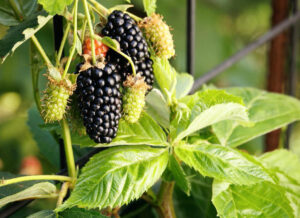
Blackberry Superlicious (Credit: Monrovia)
Monrovia Nursery’s chief marketing officer Katie Tamony rates Superlicious as the company’s best new edible introduction of 2023.
She says it’s compact enough (three to four feet tall and wide) for growing in containers and good-looking enough to “incorporate seamlessly into outdoor living spaces.”
The large, black, oblong fruits ripen in mid-summer on second-year canes. Best in full sun.
Disease-resistant hazelnuts
European hazelnut trees are small and productive with tasty nuts, but they’re nearly impossible to grow in the Eastern U.S. because of a fungal stem-canker disease called eastern filbert blight.
Researchers at Rutgers University have been crossing blight-resistant hazelnuts from different parts of the world since 1996 and now have developed four new varieties with high to excellent resistance to the disease.
Since the varieties are just hitting the market for both orchardists and home gardeners, supplies are limited and in high demand.
If you’re intrigued and can find a source, the four varieties are:
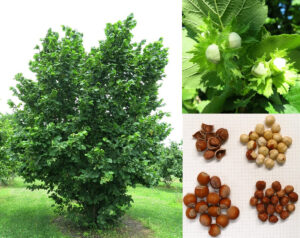
Hazelnut ‘Raritan’ (Credit: Dr. Thomas Molnar/Rutgers University)
‘Raritan.’ Produces medium-sized, round kernels that mature in the second half of September. Trees are upright and somewhat narrow, reaching 20 feet tall in 15 years.
‘Monmouth.’ Produces medium-sized, round kernels that mature in the first half of September. Trees are slightly spreading and rounded, reaching 20 feet tall in 15 years.
‘Hunterdon.’ Produces mostly round, medium- to large-size kernels, although about 25 percent are slightly oblong. Kernels are especially sweet and mature early – the end of August into the first week of September. Trees have a slightly spreading habit and reach 20 feet tall in 15 years.
‘Somerset.’ Produces small- to medium-sized, round, thin-shelled kernels that mature in the second half of September. Trees have dark-green, crinkly leaves and are compact and slightly spreading, reaching 15 feet tall in 15 years.
Note that hazelnuts are wind-pollinated and self-incompatible, meaning you’ll need at least two different trees of different varieties to produce nuts. Flowering time also must overlap.
One online retail source for all of the Rutgers introductions is New Jersey-based Foggy Bottom Hazelnuts.

Strawberry Scarlet Belle, left, and Snowy Belle, right. (Credit: Bushel and Berry)
Strawberries Scarlet Belle and Snowy Belle
Bushel and Berry is a line of cutting-edge berry plants that are bred for both productivity and ornamental value.
New to the line this year is a pair of everbearing strawberries carrying the Belle name – Scarlet Belle, which produces red flowers with yellow centers, and Snowy Belle, a white bloomer with yellow centers.
Both produce mid-sized red fruits from summer into early fall, and both have cascading habits that make them ideal for growing in pots and baskets.
Scarlet Belle grows 10 to 12 inches tall, while Snowy Belle is a tad shorter at eight to 10 inches. Production is best in full sun.
Read George’s post on Best New Vegetables and Fruits of 2022







